41°21′33″N 72°6′1″W / 41.35917°N 72.10028°W


Ye Antientist Burial Ground is a cemetery in New London, Connecticut, bounded by Hempstead Street on the west and Huntington Street on the east, running from Granite Street to approximately Bristol Street. It has been known by several names over the years, many spelling variations on Ancient Burial Ground. It is one of the earliest graveyards in New England and the oldest colonial cemetery in New London County. The hillside lot of 1.5 acres (6,000 m2) and adjoins the site of New London's first meeting house. The settlement at the time was called "Pequot Plantation" until the name changed in 1658. From the burial grounds, the visitor has a broad view to the east of the Thames River and, on the far shore, the heights of Groton, Connecticut.
History
The lot had been reserved for a burying ground and recorded as such in the summer of 1645. The first decedent "of mature age" was duly interred there in 1652. But it is the ordinance of June 6, 1653 that legally sets the place apart and declares, "It shall ever bee for a Common Buriall place, and never be impropriated by any."
A later record notes the appointment of the sexton:
Whose work is to order youth in the meeting-house, sweep the meeting-house, and beat out dogs, for which he is to have 40s. a year : he is also to make all graves ; for a man or woman he is to have 4s., for children, 2s. a grave, to be paid by survivors (Caulkins 1860, p. 111).
17th century New London was yet a rough and isolated corner of early colonial Connecticut. Private interments were not customary, and this was the only common burial place.
The dead were brought in from a distance of six or seven miles (11 km), either carried in hurdles, or borne on a bier upon men's shoulders; large companies assembling, and relieving each other at convenient distances (Prentis & Caulkins 1899, p. 7).
Few of the early graves ever had inscribed markers. The New London of that time possessed no skilled stonecutters, and those early planters simply had not the means. A few surviving families did, however, seek to address the deficiency in later years. At least four stones dated in the 17th century have been found that could not have been placed before 1720 (Slater 1987, p. 221).
If the best man in the community was struck down, his companions could do no more to testify their regret, than to lay him reverently in the grave, and seal it with a rude granite ... broken with ponderous mallets from some neighboring ledge and wearily dragged with ropes to the place and laid over the remains to secure them from disturbance, and mark the spot where a brother was buried (Prentis & Caulkins 1899, p. 6).
As time wore away the unadorned burial hillocks, the older were "covered over with fresh deposits of the dead, so that the numbers here cannot be estimated by the evidences that now remain. ... Yet here undoubtably [sic] were deposited nearly the whole generation of our first settlers" (Prentis & Caulkins 1899, pp. 5, 7).
Gravestones
During the early 1700s, Grave Carvers such as John Hartshorne and James Stanclift were carving quality grave markers that were placed in the yard. Later in the century, Eastern Connecticut carvers such as Josiah Manning, David Lamb, Gershom Bartlett, and Johnathan Loomis carved stones of granite schist and carvers from the Portland/Middletown region such as the Thomas Johnson Family and later generations of Stanclifts carved markers of brownstone that can be seen in the yard today. Many wealthy families purchased slate tombstones imported from the Boston area or coastal Rhode Island, delivered through the New London Port. The work of carvers such as the Lamsons of Charlestown Massachusetts, the John Stevens Shop of Newport Rhode Island, and James Foster & Sons of Dorchester Mass can be found in this cemetery.
Notable burials
Note: There is no way of ascertaining which of the founding colonists might have unmarked graves in this burial ground.
- Sarah Kemble Knight (1666–1727): Author (1704) of The Journal of Madame Knight. (ISBN 1-55709-115-3).[1]
- Gurdon Saltonstall (1666–1724): Governor of the Colony of Connecticut, 1708-1724.[2]
- Lucretia Harris Shaw (1737–1781): Wife of Captain Nathaniel Shaw, Jr. She turned her home into a hospital and nursed wounded and sick soldiers returning from the infamous British prison ships at Wallabout Bay (Shiel 2004). As a result, she contracted the Gaol Fever herself and succumbed. The New London chapter of the Daughters of the American Revolution is named in her honor, and her house, the Shaw-Perkins Mansion, has been preserved as the headquarters of the New London County Historical Society since 1907 (Claghorn 2003).[3]
- Thomas Short (1682–1712):[4] Printer (1710) of The Saybrook Platform.
Gallery

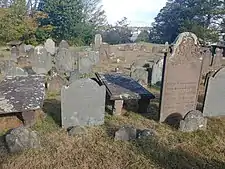 View of the Burial Ground.
View of the Burial Ground.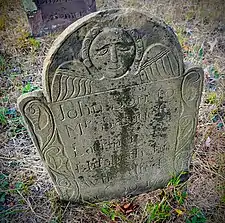 Gravestone dated 1764 carved by David Lamb of Norwich
Gravestone dated 1764 carved by David Lamb of Norwich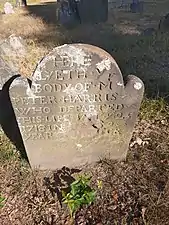 Brownstone tombstone carved by William Stanclift of Portland dated 1718.
Brownstone tombstone carved by William Stanclift of Portland dated 1718.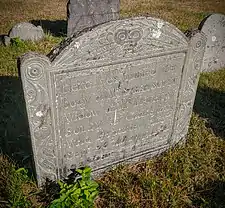 Slate Gravestone carved by Nathaniel Lamson of Charlestown Mass
Slate Gravestone carved by Nathaniel Lamson of Charlestown Mass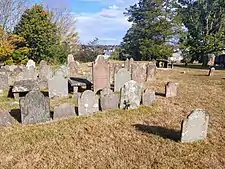 View of the rear part of the Burying Ground.
View of the rear part of the Burying Ground. Early schist grave marker carved by John Hartshorne
Early schist grave marker carved by John Hartshorne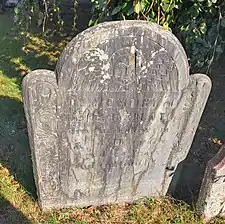 Slate marker carved by The John Stevens Shop of Newport
Slate marker carved by The John Stevens Shop of Newport
See also
References
Notes
Bibliography
- Baker, Mark Allen (2014). "Connecticut Families of the Revolution, American Forebears from Burr to Wolcott" (1st ed.). Charleston, SC: The History Press.
{{cite journal}}: Cite journal requires|journal=(help) - Caulkins, F.M. (1860). "History of New London, Connecticut" (2nd ed.). New London: The author. LCCN 26023774.
{{cite journal}}: Cite journal requires|journal=(help) - Claghorn, C.E. III (2003). "Washington's Travels In New England: A Chronological Itinerary". Florida Society - Sons of the American Revolution. Archived from the original on 2006-10-19. Retrieved 2006-10-22.
{{cite journal}}: Cite journal requires|journal=(help) — Mrs. Shaw. (See entry for April 9, 1776.) - Prentis, E.; Caulkins, F.M. (1899). Ye Antient Buriall Place of New London, Conn. New London: Day Publishing. ISBN 9781625851963. LCCN 00000181.
- Shiel, J. (2004). "Early History of Lucretia Shaw Chapter". Lucretia Shaw Chapter - Daughters of the American Revolution. Archived from the original on February 5, 2005. Retrieved 2006-10-22.
{{cite journal}}: Cite journal requires|journal=(help) - Slater, J.A. (1987). The Colonial Burying Grounds of Eastern Connecticut and The Men Who Made Them. Hamden: Archon Books. ISBN 0-208-02160-4.
- "Antientest Burial Ground 1652". The New London Gazette. Oldham Publishing. Archived from the original on 2006-09-10. Retrieved 2006-10-22. — Historical sketch.
- "How New London, Connecticut, Got Its Name". The New London Gazette. Oldham Publishing. Retrieved 2006-10-22. — Early names of settlement and river.
- "Ye Ancientest Burial Ground". New London Parks Conservancy. Archived from the original on 27 September 2007. Retrieved 2006-10-22.
Park size: 1.5 acres (6,000 m2)
- "Ye Antientist Burial Ground". Geographic Names Information System Feature Detail Report. U.S. Geological Survey. — Coordinates, elevation, and accepted place names.
Further reading
- Forbes, H.M. (1927). Gravestones of Early New England and the Men Who Made Them 1653-1800 (1967 reprint ed.). New York: Da Capo Press. ISBN 9781625851963. LCCN 67027452.
- Slater, James A. (1987). The Colonial Burying Grounds of Connecticut and the Men Who Made Them (1 ed.). Hamden CT: Archon Books.
- Stewart, D.J. (2004-09-30). 'Rocks and storms I'll fear no more': Anglo-American maritime memorialization, 1700-1940 (PhD). Texas A&M University.